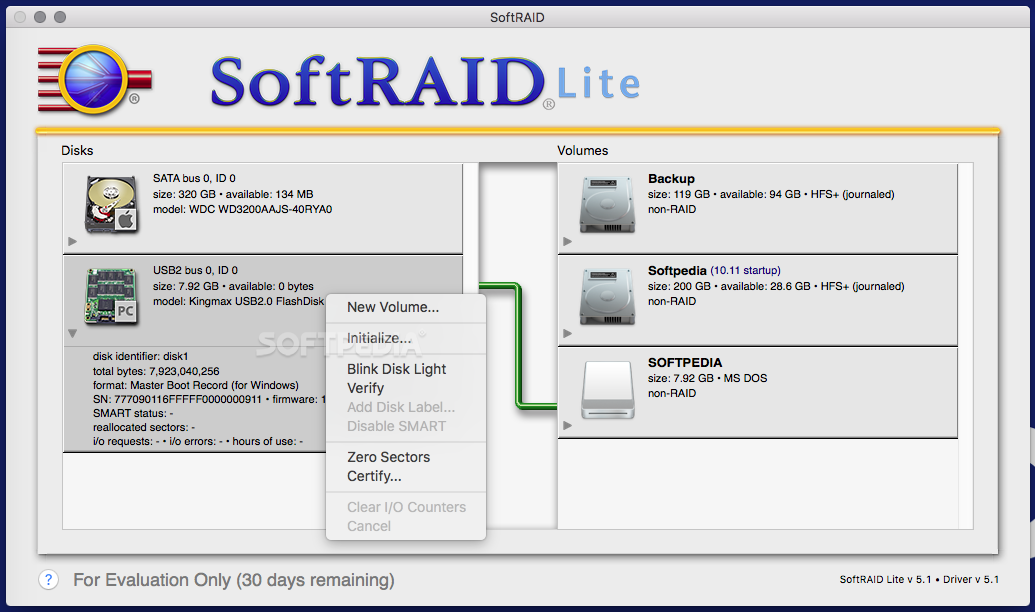

- Softraid windows how to#
- Softraid windows driver#
- Softraid windows software#
- Softraid windows windows#
Softraid windows software#
“ SoftRAID is for anyone who needs to safely store and backup important data, including audio/video pros, photographers, archivers, families, and small businesses,” said Tim Standing, VP, software development Mac. This level of performance isn’t possible in previous versions of the software and is impossible with RAID volumes not using TRIM commands, like Apple RAID. For example, using SoftRAID with an Accelsior 8M2 PCIe card enables continuous data transfer over 10GB/s. The new mechanism is 3x faster than before.
Softraid windows driver#
The re-engineered driver features a method of handling TRIM commands on SSDs. It builds on this foundation with new technology and features, making it a RAID utility.Īdds support for the new macOS 12 – Monterey.įor the first time, it supports the creation, management, and monitoring of APFS volumes and enables access to encrypted APFS volumes created with Disk Utility (1) It has features like multiple RAID options and predictive disk failure monitoring that provide a level of performance that you can’t get with hardware RAID. It is an RAID management software for macOS and Windows. (OWC) announces the SoftRAID-6.2 for Mac, adding compatibility for new macOS 12 Monterey and, for the first time, support for APFS volumes. To do this, just right-click on the unallocated space of the second drive, select New Simple Volume and follow the dialog.Ĭopy the UEFI System Volume data from the first drive to the second.Other World Computing, Inc. Then confirm this by clicking on Add mirroring.įor the UEFI System Volume, please use the following steps:Ĭreate an UEFI System Volume with the same size on the second drive and format it with FAT32. In the menu that appears, choose the second drive you would like for the RAID1. Like with Legacy, add the mirroring for the Volumes one by one, from left to right.įor all Volumes, that do not have the EFI label, follow those steps:
Softraid windows windows#
This partition cannot be mirrored automatically by Windows you need to manually copy and configure it on the second drive. UEFIĮvery UEFI system has a UEFI System Volume.


Also check that the synchronization is running, which is indicated by the reddish colored Volumes and their status information. Please check that you have correctly added all the Volumes to the mirroring. Then confirm by clicking on Add mirroring. Right-click on a Volume and choose Add mirroring from the context menu. If your system is running in Legacy mode, you should do the following steps on all the Volumes of the main disk. Now, continue below to either "Legacy" or "UEFI". If you cannot find this entry, the system is installed in the Legacy mode. In the right side of the window, you should see the BIOS MODE entry, which has the correct mode ( Legacy or UEFI) as its value. Type msinfo32.exe and press the Enter key to open the System Information window. To do this, please click on the Windows symbol in the bottom left corner, or press the Windows or Super key. Now you have to determine if your system has been installed in Legacy Mode, or in UEFI Mode. Please also select the other drive which you would like to use for the RAID1. In the dialog that then appears, the main drive should already be selected. Right-click on the disk which currently contains the operating system and click on Convert to dynamic disk. If your second disk already has Volumes on it, please right-click on them and choose Delete Volume on all of them.
Softraid windows how to#
The following guide describes how to manually setup a drive mirroring (RAID1) in a Windows operating system. Windows Server Software RAID Last change on


 0 kommentar(er)
0 kommentar(er)
